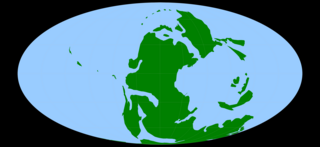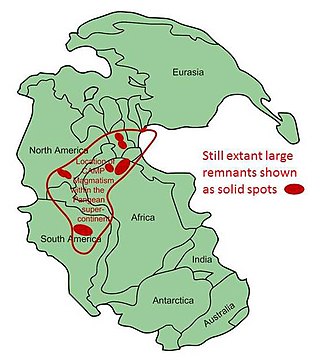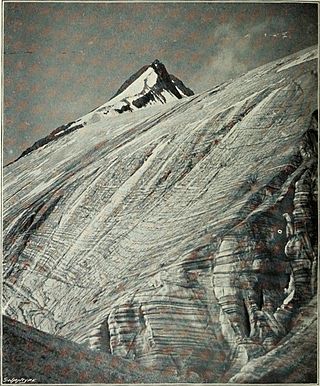Related Research Articles

The Deccan Traps is a large igneous province of west-central India. It is one of the largest volcanic features on Earth, taking the form of a large shield volcano. It consists of numerous layers of solidified flood basalt that together are more than about 2,000 metres (6,600 ft) thick, cover an area of about 500,000 square kilometres (200,000 sq mi), and have a volume of about 1,000,000 cubic kilometres (200,000 cu mi). Originally, the Deccan Traps may have covered about 1,500,000 square kilometres (600,000 sq mi), with a correspondingly larger original volume. This volume overlies the Archean age Indian Shield, which is likely the lithology the province passed through during eruption. The province is commonly divided into four subprovinces: the main Deccan, the Malwa Plateau, the Mandla Lobe, and the Saurashtran Plateau.

An extinction event is a widespread and rapid decrease in the biodiversity on Earth. Such an event is identified by a sharp fall in the diversity and abundance of multicellular organisms. It occurs when the rate of extinction increases with respect to the background extinction rate and the rate of speciation. Estimates of the number of major mass extinctions in the last 540 million years range from as few as five to more than twenty. These differences stem from disagreement as to what constitutes a "major" extinction event, and the data chosen to measure past diversity.

The Permian is a geologic period and stratigraphic system which spans 47 million years from the end of the Carboniferous Period 298.9 million years ago (Mya), to the beginning of the Triassic Period 251.902 Mya. It is the last period of the Paleozoic Era; the following Triassic Period belongs to the Mesozoic Era. The concept of the Permian was introduced in 1841 by geologist Sir Roderick Murchison, who named it after the region of Perm in Russia.

Approximately 251.9 million years ago, the Permian–Triassicextinction event forms the boundary between the Permian and Triassic geologic periods, and with them the Paleozoic and Mesozoic eras respectively. It is the Earth's most severe known extinction event, with the extinction of 57% of biological families, 83% of genera, 81% of marine species and 70% of terrestrial vertebrate species. It is also the largest known mass extinction of insects. It is the largest of the "Big Five" mass extinctions of the Phanerozoic. There is evidence for one to three distinct pulses, or phases, of extinction.

A geologic hazard or geohazard is an adverse of geologic condition capable of causing widespread damage or loss of property and life. These hazards are geological and environmental conditions and involve long-term or short-term geological processes. Geohazards can be relatively small features, but they can also attain huge dimensions and affect local and regional socio-economics to a large extent.

The Siberian Traps is a large region of volcanic rock, known as a large igneous province, in Siberia, Russia. The massive eruptive event that formed the traps is one of the largest known volcanic events in the last 500 million years.

A flood basalt is the result of a giant volcanic eruption or series of eruptions that covers large stretches of land or the ocean floor with basalt lava. Many flood basalts have been attributed to the onset of a hotspot reaching the surface of the Earth via a mantle plume. Flood basalt provinces such as the Deccan Traps of India are often called traps, after the Swedish word trappa, due to the characteristic stairstep geomorphology of many associated landscapes.
The Guadalupian is the second and middle series/epoch of the Permian. The Guadalupian was preceded by the Cisuralian and followed by the Lopingian. It is named after the Guadalupe Mountains of New Mexico and Texas, and dates between 272.95 ± 0.5 – 259.1 ± 0.4 Mya. The series saw the rise of the therapsids, a minor extinction event called Olson's Extinction and a significant mass extinction called the end-Capitanian extinction event. The Guadalupian was previously known as the Middle Permian.

A large igneous province (LIP) is an extremely large accumulation of igneous rocks, including intrusive and extrusive, arising when magma travels through the crust towards the surface. The formation of LIPs is variously attributed to mantle plumes or to processes associated with divergent plate tectonics. The formation of some of the LIPs in the past 500 million years coincide in time with mass extinctions and rapid climatic changes, which has led to numerous hypotheses about causal relationships. LIPs are fundamentally different from any other currently active volcanoes or volcanic systems.

The Central Atlantic magmatic province (CAMP) is the Earth's largest continental large igneous province, covering an area of roughly 11 million km2. It is composed mainly of basalt that formed before Pangaea broke up in the Mesozoic Era, near the end of the Triassic and the beginning of the Jurassic periods. The subsequent breakup of Pangaea created the Atlantic Ocean, but the massive igneous upwelling provided a legacy of basaltic dikes, sills, and lavas now spread over a vast area around the present central North Atlantic Ocean, including large deposits in northwest Africa, southwest Europe, as well as northeast South America and southeast North America. The name and CAMP acronym were proposed by Andrea Marzoli and adopted at a symposium held at the 1999 Spring Meeting of the American Geophysical Union.
In the geologic timescale, the Capitanian is an age or stage of the Permian. It is also the uppermost or latest of three subdivisions of the Guadalupian Epoch or Series. The Capitanian lasted between 264.28 and 259.51 million years ago. It was preceded by the Wordian and followed by the Wuchiapingian.

The end-Botomian mass extinction event, also known as the late early Cambrian extinctions, refer to two extinction intervals that occurred during Stages 4 and 5 of the Cambrian Period, approximately 513 to 509 million years ago. Estimates for the decline in global diversity over these events range from 50% of marine genera up to 80%. Among the organisms affected by this event were the small shelly fossils, archaeocyathids, trilobites, brachiopods, hyoliths, and mollusks.
The Skagerrak-Centered Large Igneous Province (SCLIP), also known as the European-Northwest African Large Igneous Province (EUNWA), and Jutland LIP, is a 300 million year old (Ma) large igneous province (LIP) centered on what is today the Skagerrak strait in north-western Europe. It was named by Torsvik et al. 2008.

The Panjal Traps or the Tethyan Plume is a large igneous province (LIP) that erupted during the Early–Middle Permian in what is now north-western India. The Panjal Traps are associated with the opening of the Neo-Tethys Ocean, which resulted in the dispersal of the Cimmerian continental blocks from the north-eastern margin of Gondwana and possibly the break-up of this old and large continent. In the Zanskar-Spliti-Lahaul area the 30–150 m (98–492 ft)-thick basalts of the Panjal Traps are mostly exposed as massive (terrestrial) lava flows, but also as (marine) pillow lavas and hyaloclastites.

The Capitanian mass extinction event, also known as the end-Guadalupian extinction event, the Guadalupian-Lopingian boundary mass extinction, the pre-Lopingian crisis, or the Middle Permian extinction, was an extinction event that predated the end-Permian extinction event. The mass extinction occurred during a period of decreased species richness and increased extinction rates near the end of the Middle Permian, also known as the Guadalupian epoch. It is often called the end-Guadalupian extinction event because of its initial recognition between the Guadalupian and Lopingian series; however, more refined stratigraphic study suggests that extinction peaks in many taxonomic groups occurred within the Guadalupian, in the latter half of the Capitanian age. The extinction event has been argued to have begun around 262 million years ago with the Late Guadalupian crisis, though its most intense pulse occurred 259 million years ago in what is known as the Guadalupian-Lopingian boundary event.
Paul Barry Wignall is a British palaeontologist and sedimentologist. He is best known for his research on mass extinctions in the marine realm., particularly via the interpretation of black shales.
Asish R. Basu is a geologist, academic, and researcher. He is Professor Emeritus of Earth and Environmental Sciences at the University of Texas at Arlington. He is most known for his research in Earth Science -related subjects, such as isotope geochemistry, flood basalt volcanism, and mineralogy-petrology.
References
- Citations
- ↑ Bond, D. P. G.; Wignall, P. B.; Joachimski, M. M.; Sun, Y.; Savov, I.; Grasby, S. E.; Beauchamp, B.; Blomeier, D. P. G. (2015-04-14). "An abrupt extinction in the Middle Permian (Capitanian) of the Boreal Realm (Spitsbergen) and its link to anoxia and acidification" (PDF). Geological Society of America Bulletin. 127 (9–10): 1411–1421. Bibcode:2015GSAB..127.1411B. doi: 10.1130/B31216.1 . ISSN 0016-7606.
- ↑ Trap at dictionary.reference.com
- 1 2 Wignall, PB; et al. (2009). "Volcanism, Mass Extinction, and Carbon Isotope Fluctuations in the Middle Permian of China". Science. 324 (5931): 1179–82. Bibcode:2009Sci...324.1179W. doi:10.1126/science.1171956. PMID 19478179. S2CID 206519019.
- 1 2 Jerram, DA; et al. (2015). "Submarine palaeoenvironments during Emeishan flood basalt volcanism, SW China: Implications for plume–lithosphere interaction during the Capitanian, Middle Permian ('end Guadalupian') extinction event" (PDF). Palaeogeography, Palaeoclimatology, Palaeoecology. 441: 65–73. doi:10.1016/j.palaeo.2015.06.009.
- ↑ Zheng, LD; et al. (2010). "Magnetostratigraphic constraints on two‐stage eruptions of the Emeishan continental flood basalts". Geochemistry, Geophysics, Geosystems. 11 (12): Q12014. Bibcode:2010GGG....1112014Z. doi:10.1029/2010GC003267.
- ↑ Zhong, YT; et al. (2014). "CA-TIMS zircon U–Pb dating of felsic ignimbrite from the Binchuan section: Implications for the termination age of Emeishan large igneous province". Lithos . 204: 14–19. Bibcode:2014Litho.204...14Z. doi:10.1016/j.lithos.2014.03.005.
- ↑ Zhou, MF; et al. (2002). "A temporal link between the Emeishan large igneous province (SW China) and the end-Guadalupian mass extinction". Earth and Planetary Science Letters. 196 (3–4): 113–122. Bibcode:2002E&PSL.196..113Z. doi:10.1016/s0012-821x(01)00608-2.
- ↑ Ali, JR; et al. (2005). "Emeishan large igneous province, SW China". Lithos. 79 (3–4): 475–489. Bibcode:2005Litho..79..475A. doi:10.1016/j.lithos.2004.09.013.
- ↑ Zhu, B; et al. (2014). "No pre-eruptive uplift in the Emeishan large igneous province: New evidences from its 'inner zone', Dali area, Southwest China". Journal of Volcanology and Geothermal Research. 269: 57–67. Bibcode:2014JVGR..269...57Z. doi:10.1016/j.jvolgeores.2013.11.015.
- ↑ Wignall, PB; et al. (2001). "Large igneous provinces and mass extinctions". Earth-Science Reviews. 53 (1): 1–33. Bibcode:2001ESRv...53....1W. doi:10.1016/s0012-8252(00)00037-4.
- ↑ Courtillot, VE; et al. (2003). "On the ages of flood basalt events". Comptes Rendus Geoscience. 335: 113–140. Bibcode:2003CRGeo.335..113C. CiteSeerX 10.1.1.461.3338 . doi:10.1016/S1631-0713(03)00006-3.
- ↑ Shen, Minglian; Dai, Shifeng; Nechaev, Victor P.; French, David; Graham, Ian T.; Liu, Shande; Yu. Chekryzhov, Igor; Tarasenko, Irina A.; Zhang, Shaowei (1 January 2023). "Provenance changes for mineral matter in the latest Permian coals from western Guizhou, southwestern China, relative to tectonic and volcanic activity in the Emeishan Large Igneous Province and Paleo-Tethys region". Gondwana Research . 113: 71–88. doi:10.1016/j.gr.2022.10.011. ISSN 1342-937X . Retrieved 10 December 2023.
- Bibliography
- Dobretsov, N. L. (2005). "Large Igneous Provinces of Asia (250 Ma): Siberian and Emeishan traps (plateau basalts) and associated granitoids". Geologiya I Geofizika. 46: 870–890.
- He, Bin; Xu, Yi-Gang; Chung, Sun-Ling; Huang, Xiao-Long; Wang, Ya-Mei (2003). "Sedimentary evidence for a rapid kilometer-scale crustal doming prior to the eruption of the Emeishan flood basalts". Earth and Planetary Science Letters. 213 (3–4): 391–405. Bibcode:2003E&PSL.213..391H. doi:10.1016/s0012-821x(03)00323-6.
- He, Bin; Xu, Yi-Gang; Huang, Xiao-Long; Luo, Zhen-Yu; Shi, Yu-Ruo; Yang, Qi-Jun; Yu, Song-Yue (2007). "Age and duration of the Emeishan flood volcanism, SW China: Geochemistry and SHRIMP zircon Uranium–U-Lead–Pb dating of silicic ignimbrites, post-volcanic Xuanwei Formation and clay tuff at the Chaotian section". Earth and Planetary Science Letters. 255 (3–4): 306–23. Bibcode:2007E&PSL.255..306H. doi:10.1016/j.epsl.2006.12.021.
- Koeberl, Christian, and Francisca C. Martinez-Ruiz, eds. (2003) Impact Markers in the Stratigraphic Record. New York, Springer-Verlag.
- Yuen, David A., Shinegoru Maruyama, Shun-Ichiro Karato, and Brian F. Windley, eds. (2007) Superplumes: Beyond Plate Tectonics. New York, Springer-Verlag.